If you’ve been following my home remodels, you know I am not a fan of rough wall texture and do a lot of skim coating to get smooth walls. Skim coating means skimming a thin layer of joint compound or plaster to your walls. The materials needed are fairly inexpensive so the cost of having it done by a professional is mostly for labor. If you have the time and patience to do it yourself, skim coating can be done using a $25 Magic Trowel and a thick nap paint roller.
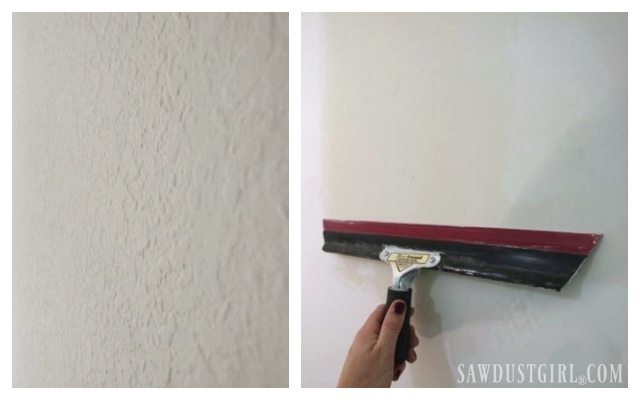
How to skim coat
Prep your space
Drywall work can get really messy so take a little time to prep your space before you start mixing your drywall compound. Cover the floors, furniture, appliances, etc, and seal off the room you’re working on to contain the dust to that room. If you just jump in and start skim coating, you’ll probably end up cleaning drywall dust out of every nook and cranny of your house for a few months.
Baseboards and Outlets
Remove your baseboards. Trust me. It will be way less work to reinstall them than try to work around them. Also remove outlet and switch covers and tape off all outlets to keep drywall cement out of them.
Gather your supplies
- all purpose joint compound
- Paint tray, mud pan, or 5 gallon bucket
- mixing attachment for your drill
- thick nap paint roller
- spray bottle with water to thin you joint compound
- wet rag
- Magic Trowel
- drop cloth (floor coverings)
- drywall sander
If you’re doing a small area where you’ll only need one bucket, I’d choose a ready mix joint compound. It costs about $15 for a 5 gallon bucket. So for $15 you get the mud and a bucket.
Powder joint compound is much cheaper. You can get about 4 times the coverage with dry mix mud. If you’re doing a LOT of skim coating, dry is probably a cost effective option. You still need the 5 gallon bucket which runs about $4-5.
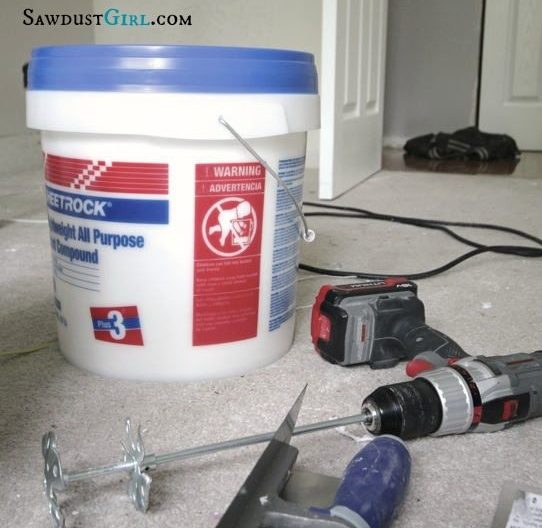
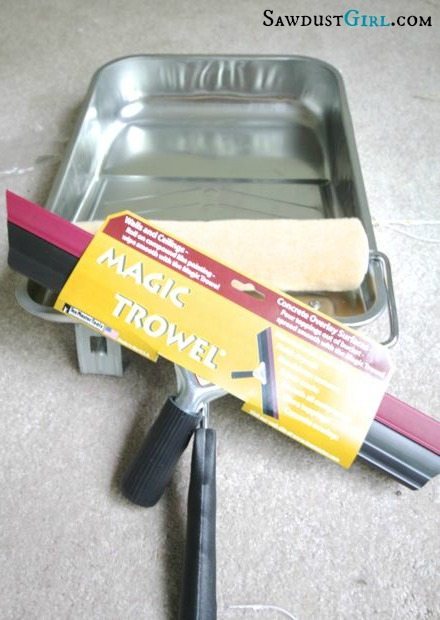
Prepare the joint compound
Use a a mixing attachment for your drill to mix the joint compound to the consistency of thick pancake batter. It’s got to be thin enough for you to smooth it on the wall but not so thin that it just drips and dribbles down the wall. You may have to play around with it until you get the “just right” consistency. Most importantly, make sure there aren’t any lumps.
If you’re using ready mix mud, add a little water at a time so you don’t end up making it too runny. This is where dry mix can be beneficial. If it does end up too runny, add more dry mix.
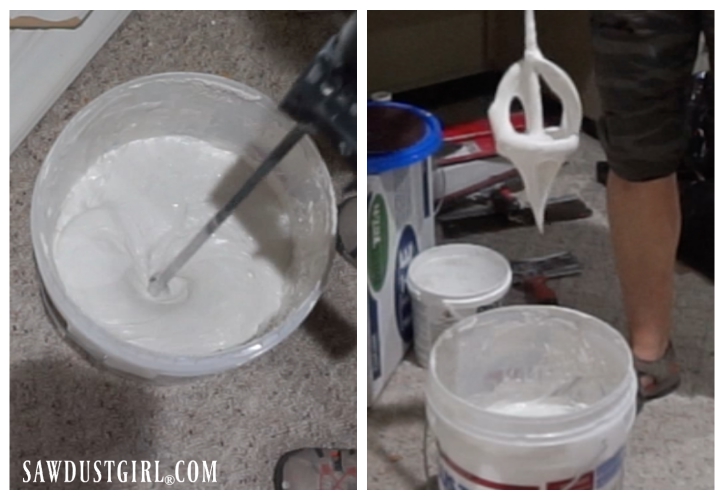
Apply joint compound to wall
Work in small sections at a time. The mud is watered down so it will dry fairly quickly and you have to apply it to the wall and then skim it smooth. I generally work in 4’x4′ sections. Depending on the temperature and humidity of the room you’re working in, you may be able to do larger sections.
Using a thick nap paint roller, apply a generous amount of mud to the wall. Using a roller allows you to get more compound on the wall faster than if you were scooping it out with a putty knife. You can pour joint compound into a roller tray or dip the roller directly into the 5 gallon bucket.
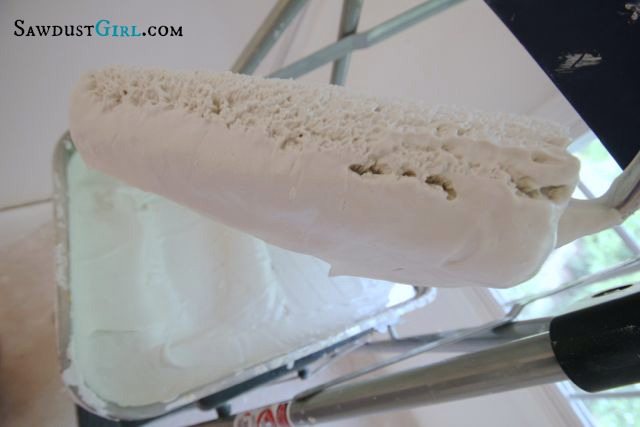
I generally prefer the bucket method because it’s faster but it is also messier because the excess mud drips off the roller as you pull it out of the bucket.
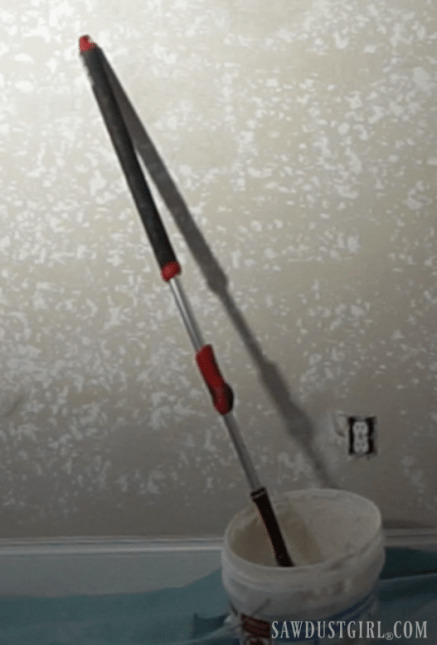
Skim the walls with the Magic Trowel
After rolling the mud onto your first section, use the magic trowel to smooth it out. The first coat won’t be perfectly smooth. The compound is filling the voids that around the raised surfaces in the existing texture. If you have a really heavy texture, you’ll need more layers of joint compound.
- Each coat of mud should be smoothed in the same direction as it was applied onto the wall with the roller.
- Alternate directions of each consecutive coat.
- If you rolled the mud onto the wall vertically on the first coat, switch to horizontal application for the next coat.
After smoothing out your first section of wall, you’re ready to roll another section with joint compound.
- Keep a wet edge. That’s where the spray bottle full of water comes in handy. Before you start rolling compound onto your second section, lightly mist the edge of the area you just smoothed.
- Slightly overlap the first section as you roll the second section.
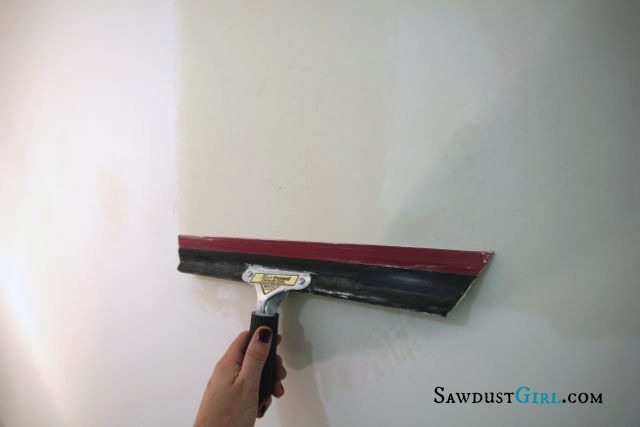
The Magic Trowel is like a squeegee. It’s a rubber blade on a handle. It does come with a cover over the blade. Make sure to remove the blade cover!
- Use your damp rag or spray bottle to wet the blade before use.
- Pull the Magic Trowel over the compound, smoothing it out.
- Squeegee the mud in the same direction that you applied it with the paint roller.
If you have really heavily texture patterns, the first coat will not produce perfectly smooth walls. The Magic Trowel may create gouges or new lines. Don’t freak out. The next coat will fix that.
Light your work surface
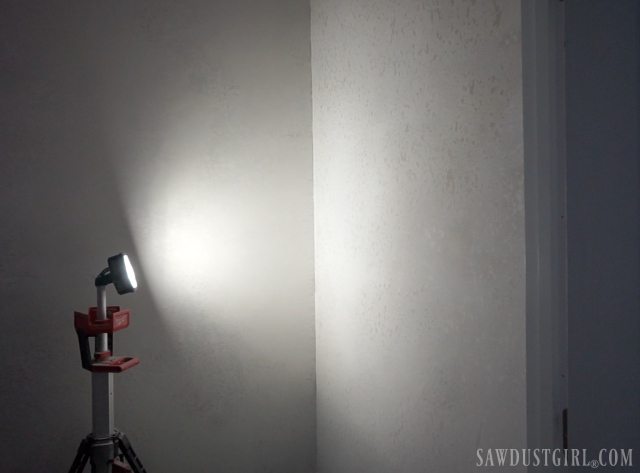
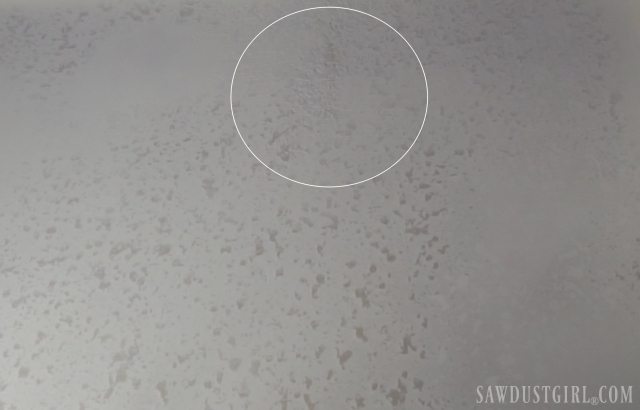
Shining a light at an angle on the wall you’re working on. The angle is important because it allows you to see more imperfections than you see with down lighting. This is true when priming and painting as well. When you think you’re done, move the light so it’s shining from a different angle. You’ll be surprised to see how many areas you missed. The below picture demonstrates a wall I thought was finished until I moved the light and illuminated my wall from a different angle.
Sanding Drywall
You can lightly sand in between coats but it’s not necessary. Each consecutive coat with the Magic Trowel will make the wall more and more smooth. If anything, you may have lines created by the excess mud sliding off the edge of the trowel as you skimmed over the wall. These lines are very easy to get rid of with a quick sanding. If you find a big blob of dried mud you can scrape it off with a drywall knife, rather than create all the dust from sanding it away.
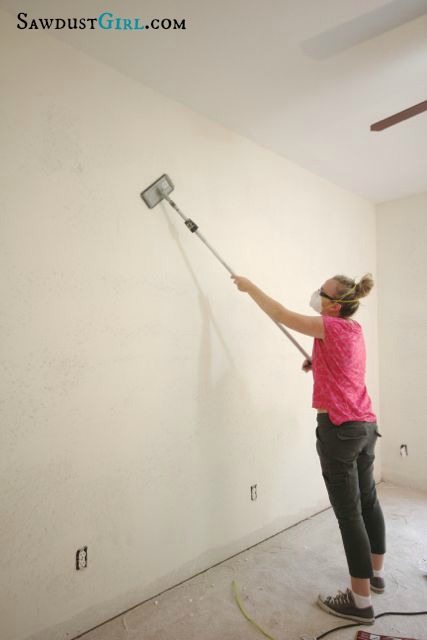
Drywall sanding can be VERY dusty. You shouldn’t have much to sand after skim coating. Just a gentle sanding over the whole surface with a very light grit sandpaper. Sanding without a vacuum attachment will make a BIG MESS everywhere in your house. You have 3 options:
- Use a regular pole sander and worry about cleaning up the dust later. Make sure you wear a dust mask or respirator.
- Wet sand. Use a slightly damp tiling sponge to gently rub away lines and imperfections.
- Use a dust free drywall sander (This is definitely worth the $30 price tag.)
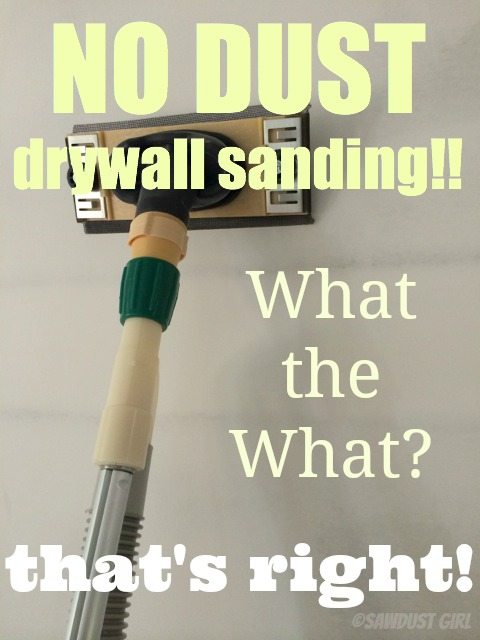
You can also use a box fan to reduce dust when sanding drywall.
I’ll be frank with you, skim coating is messy. It takes some practice to learn the skill. It’s hard work. It’s tiring and can be frustrating. But smooth walls are worth the effort!
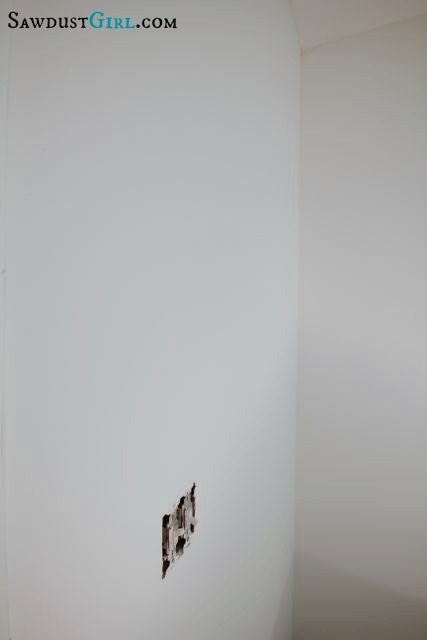
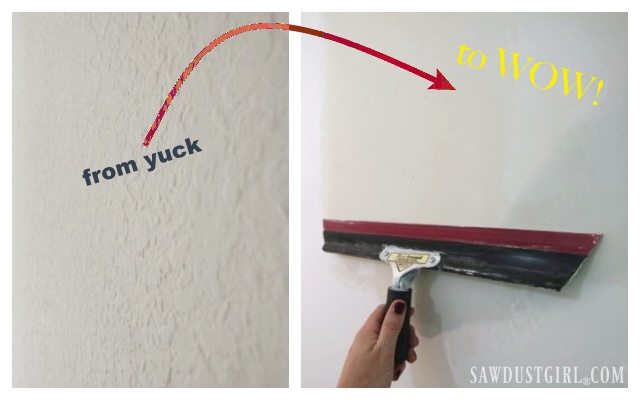
Right?
It’s definitely a personal thing. Some people like orange peel and other textured finishes. Give me a crisp, clean, smooth wall any day of the week! So what do you think? Now that you know how to skim coat, are you going to give it a try? Just remember to protect your floors. Unless you’re working in a room where you’re going to remove the carpet. If that’s the case, go ahead and use that carpet as your drop cloth and don’t worry if you drop blobs of joint compound. Just don’t step in them and track it all over the house. Ehem…lesson learned!
Prime and Seal
One more thing; Just like with new drywall, make sure to prime skim coated walls with a PVA primer before painting. PVA primer seals the pores, and prepares the walls for paint. A lot of paint nowadays, is paint+ primer in one bucket but I always use PVA primer first. It dries quickly and then I can move on to paint.
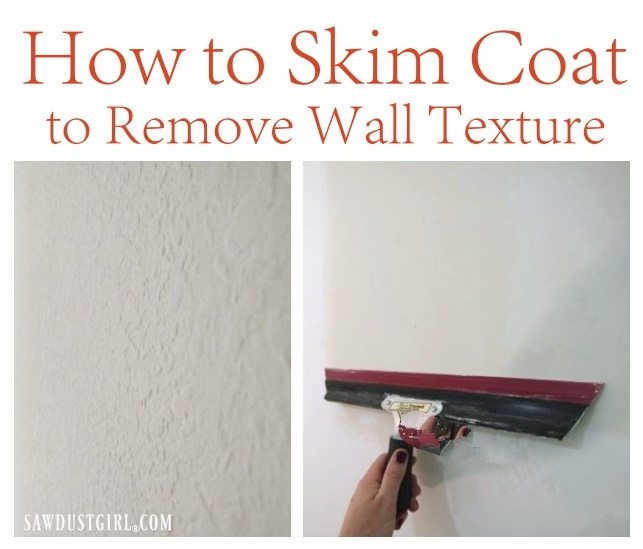

Ana. says
Your page is full of adds. It is impossible to read it watch your videos.
Sandra says
Sorry, I don’t have any experience with stucco.
Twila says
We have a straw bale house in NW Florida with interior (and exterior) tinted true stucco walls with the sand grit prominently raised. Our son with Down Syndrome has problems with the dust which catches on the walls as we use a ceiling fan regularly and he IS a guy re: house cleaning. What is the best way to smooth the finish? Must I skim coat with sheet rock mud? can that be tinted or must it then be again painted? Is there a thick paint I can just roll on? As you can imagine this is a low budget DIY project. Suggestions?
Kelsey says
Do you have to primer or sand the walls a bit beforehand? Or will the skim coat adhere well to an already textured and painted wall? I just don’t want it to chip off down the road
Melinda says
What is the advantage of the “Magic Trowel” over regular drywall trowels?
Diana Chandler says
Hello! Just found your blog looking for a way to skim coat my walls after removing wallpaper—1982 house covered in wall paper! There is some damage to the drywall, would you recommend priming before skim coating? Thank you for this great blog!
Sandra says
I have never worked on actual plaster walls so I can’t help.
Marie says
What do you reccommend for reparing cracks and holes in plaster walls?
Andrea says
Thanks so much for this guidance! I have a house built in 1910 and want to install aluminum flashing as a backsplash on a wall with heavily textured plaster. Since there’s certainly lead paint beneath the current color, sanding isn’t an option. I’m lucky I don’t have to achieve a perfect finish. Just can’t have little plaster bumps showing through the sheet of metal.
Patti says
Actually, I meant PLASTER walls! LOL!
Patti Herson says
I want to make my walls look like white rustic plastic walls. What do you think of mixing paint in with the joint compound to create that?
Tami says
Use a 4″ or 6″ drywall knife and just scrape the old sand paint off the wall. I was amazed at how smooth the wall was when a hired pro did it to my bathroom. I’ve done it on other walls myself.
Samantha says
Definitely hands down the best instructional guide you can find on the internet && I love the fact you added the shopping list. I do wish I was able to just click on the item and it directs me to Amazon lol thankyou for this it gives my ugly walled room hope! I hope my walls end up as
❤️ beautiful❤️ as yours!
Sandra says
Yes, it makes it so much easier to not have to navigate around those.
Emily says
Did you remove the baseboard and trim before skim coating?
Sandra says
I have no idea. Maybe test each area.
Watson Childs says
I have removed pre-pasted wall paper that was applied with paste activator and scrubbed down walls twice to remove residual paste. In another area removal of different paper (applied earlier) pulled part of the paint (primer?) from the drywall and that area was also scrubbed. Can I skim coat both areas without additional treatment first?
Sandra says
I know professional mudders use different materials for different coats. When I’m skim coating, I just use the general purpose. You don’t want a fast drying time because you’re going to work it a bit.
Mike says
Is there a dry compound you recommend? The selection at our local home improvement store is dizzying. There are so many different types, and drying times. We are looking to skim coat textured drywall in our entire house. So, I would prefer to use the dry compound mix. I’m just not sure what to buy and keep receiving conflicting advice from the staff there.
Sandra says
I can’t see any point of skim coating the portion of wall that will be covered. If you ever remove the beadboard, then that portion of wall would require attention. 🙂
Adriana says
Hi! Thanks for this great article!
I only need to smooth out the top third of my bathroom walls (for wallpaper). Would you recommend skim coating the entire wall if I’m covering the bottom portion with bead board?
Sandra says
No I haven’t. That would be such a chore. In a lot of rooms, I covered the ceiling with V-groove planking but some I just left the texture. I don’t mind when it’s just the ceiling.
Jenn says
Hi Sandra,
Just found your site through a search for how to skim coat and love it! Just started on my office this week and it is so satisfying! I am wondering if you do your ceilings as well? I think I would faint from the dizziness and wondered if it would be strange just to leave them and try not to look? Haha!
THANK YOU!
Jenn
Sandra says
No idea. If you try it, I’d love to know how it worked out for you.
florence hampl says
can this be done on basement cinder block walls? thanks!
Scarlet Aaron says
Thank you for posting. Texturing walls is a time-honored method of adding character to a wall or covering such imperfections as drywall taping inconsistencies but not everyone loves the ridges and swirls of knock-down or the soft ripples of orange peel.
Steve Long says
Use TSP to clean the surface. Its strong enough to cut the gloss and soften the paint just a little then I would prime before mudding
Pam Ledbetter says
Thank you for the information! I’m going to do a small nook area that I want to wallpaper .
Sandra says
I’m guessing they actually used actual plaster. I haven’t ever used it and don’t have any tips about using it. I don’t think adding plaster of paris to premixed mud sounds like a good idea though. Maybe you could ask a mudding expert.
Candy Vivier says
Can I add plaster of paris to pre mixed drywall mud to make “hot mud? ” I have read that it makes the finish stronger and more plaster like. Would it be harder to keep it wet enough to magic trowel? Or to sand? The previous reno people did the same thing yours did, knock down and didn’t knock it down. I SWEAR they added paster of paris because it’s hard and pokey and will NOT sand down and no amount of water will soften it up to scrape.
Sandra says
If you have it in the budget, it might be worth buying a heavy duty, power drywall sander. I have a Festool but there are a lot of other brands at lots of different prices. They get heavy but man do they sand fast! You can use a really course grit sandpaper to take off that heavy texture.
Jane says
Can surfaces be too heavily textured to skim coat? We recently purchased a house with a very thick texture on the living room walls and ceilings. It appears to have several coats of high gloss paint over the top and the paint doesn’t reach all the way into the “valleys” of the texture. It’s just so heavy and so thick and so spiky, I’m not convinced it can be skim coated effectively without adding a lot of weight to the plaster walls underneath. I think covering it with drywall will save time and sanity but my husband is convinced we can skim coat it. Neither of us have hung drywall or skim coated before. I worry scraping will be too difficult due to the amount of texturization. It’s not orange peel. More like mountain ranges. I think it was rolled on with a sponge painting roller or something similar. Truly awful.
Dimitri says
Great read. Well done. An alternative method (but equally laborious) is to sand the walls down using a finishing sander. It takes out all the plaster pimples and creates a very smooth finish. The new paint then does the same job of filling as the process you have just described. I did this to my last home and was immensely proud. Most people never noticed the amount of work that goes into creating brilliant walls, but it makes a huge difference. Well done to you and keep up the great work.
Sandra says
On flat walls I use a roller with a small nap. The sheen you choose is completely up to you and generally depends on the room. Bathrooms, some people like to use a higher sheen. I personally like flat or satin on walls because I don’t like shiny walls.
JodI says
Once you have your flat walls, what do you recommend roller and paint sheen wise to achieve the cleanest look and not apply texture again.
CEDRA D RUBIN says
Hello
I’m looking to see if sanding is needed for a ceiling that has a popcorn surface and paint on it?
Sandra says
Once you’re happy with the finish of the wall, prime and paint.
Cole says
What do you do after the skim coat is complete? Do you just prime and paint?
Sandra says
If the walls are glossy you can sand them a little. If it’s flat paint I don’t sand. I’d personally test out a spot of the wall to see if the mud will stick to the walls before deciding if I need to add another step to the process.
Lise says
Do you need to sand or prep the walls in any way before applying the first skim coat? Thanks 🙂
Moo Kahn says
This is exactly how the ‘pros’ do a level 5 drywall finish… roll on, trowel off. I’ve lost track of how many 100,000 SF of skimming old walls I’ve done this way. I’m helping my daughter and husband reno a fixer-upper and was looking for this exact tutorial. I’ve always used a flexible blue steel “wiping” trowel – but I ordered the Bon squeegee trowels (18 and 22 – no doubt one will do better than the other and we’ll wind up with a preference we don’t have currently LOL). One tip for everyone – I’ve found it helpful to do all the edges first one coat in a separate operation. It establishes a “ground” to wipe against for your “field” coat, and it allows you to not have to roll so tightly into the corners. You will have a visible “coat line” between the corner coat and the first coat in the field of the wall or ceiling – but a damp sponge or 220 drywall sandpaper will easily get rid of that. Tip #2 – I put a 4′ handle on my roller and wiping trowel – it allows me to never need any kind of ladder or scaffolding.
Anne says
Can you do this on the ceiling? I have a bad patch job and we have stomped ceilings. What is the best way to remedy this? I don’t really care if it’s smooth or re-stomped, but I just hate where it is right now
Sandra says
Yes it absolutely is a concern. We tested everything before we began demo.
Sophia says
Do you know whether asbestos should be a concern with this type of project? Asbestos is likely in the drywall for many homes built before 1980…im wondering (and I could be totally wrong) if sanding down the drywall could potentially release some asbestos. Maybe not because it seems like you’re really just removing the joint compound…but thought I would ask.
Kim says
can you hang pictures, art work etc normally over skimmed walls? doe it require any special hardware and what are the chances of it flaking?
Erika M says
I have an older home (built in 1985) and the walls and ceiling are very bumpy. I despise it and want to get rid of it all. Is this the best method for my walls and ceiling as well? Its small home 1,000 sq ft.
Ricky hess says
Can I do the skim coating over walls that have been painted with sand in the paint?
Andrea says
Have you ever used a damp sanding sponge to sand the walls at the end? I guess it would probably work better on a small area since they are tiny but I tried that method on a patch I did and it worked great for me with no dust at all. You do have to continuously rinse and squeeze out though. I’m assuming it is similar to the damp sponge method but the grit probably helps to move along the process a bit.
Sophia says
Question, so my house has a high gloss paint with a horrible what looks like tossed oatmeal texture in random locations– would i be able to skim coat over that? Or would you recommend sanding first? I really want a smooth surface!!
Heather says
Can you do this on a textured ceiling? Thanks!
Sandra says
Believe me, I’ve done it many different ways too. I love finding new ways to do things faster and better!
Sandra says
Thanks so much for sharing!
Mariele says
Wowza!! I did this myself in my bedroom using a regular trowel to apply and smooth with, and a sanding sponge… took me a week to do. If only I’d known about this method! 🙂 Bookmarked for future reference. Thank you so much for the guide!
Rachel Lynn says
Perfect. I needed a DIY on this for my remodeling/home improvement board on Pinterest and I didn’t have any walls to fix myself. lol Scheduled it to go out!
Laura says
I know you have a wicked sense of humour…I kinda thought you slipped that one in to see if anyone would notice 😉
Sandra says
lol Thanks for catching my typo. I think that’s a good idea though!
Laura says
Love your drywall sanding choices!
1) Pole Sander
2) Wes sand
3) Dust free sander.
If I were you I’d choose #2 ~ Get Wes to sand the walls 🙂